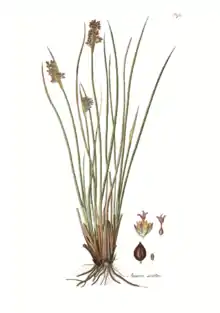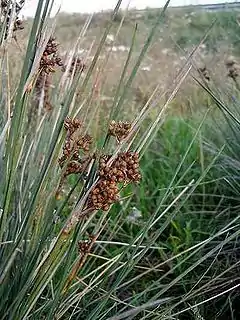Juncus acutus
Juncus acutus, the spiny rush, sharp rush or sharp-pointed rush, is a flowering plant in the monocot family Juncaceae.
| Juncus acutus | |
|---|---|
 | |
| Scientific classification | |
| Kingdom: | Plantae |
| Clade: | Tracheophytes |
| Clade: | Angiosperms |
| Clade: | Monocots |
| Clade: | Commelinids |
| Order: | Poales |
| Family: | Juncaceae |
| Genus: | Juncus |
| Species: | J. acutus |
| Binomial name | |
| Juncus acutus | |
It grows in salt marshes[2] and on dunes[3] and is reliable for reducing erosion rates.[4] In some countries like Australia it is considered to be an invasive weed[5] and the spines harmful to young children.[6]
Synonyms
- Juncus acutus ssp. leopoldii (Parl.) Snog. -- Leopold's rush[7]
- Juncus acutus L. var. sphaerocarpus Engelm[8]
- Juncus acutus L. subsp. acutus
- Juncus spinosus Forssk[9]
- Juncus acutus ssp. leopoldii also known as Leopold's rush is a native of Arizona, California, Georgia and Nevada.[1][8]
- Juncus acutus L. var. conglobatus Trautv
- Juncus acutus L. var. decompositus Guss
- Juncus acutus L. var. longibracteatus Buchenau[10]
Description
Juncus acutus is a brown and green[11] "tussocky"[6] perennial that can be to 1.5 metres (4.9 ft)[11] tall in all kinds of soils,[12] in areas which go from extremes in flood and dry like dunes[3] or that just stay wet like lowland grassland and grassy woodland, riparian vegetation, freshwater wetland, and saline and subsaline wetlands.[13]
- Stems and leaves
- Pith filled stems and leaves arise from the base at different angles giving the plant a globe shape. The leaves form a basal sheath around the flower stem leaves and end with a stiff sharp point.[6]
- Flowers
- The flower stems are 2 millimetres (0.079 in) to 4 millimetres (0.16 in) in diameter and 4 centimetres (1.6 in) to 13 centimetres (5.1 in) long and are similar to the leaves. They emerge from the base at all angles and each have 1 - 6 flowers. Each flower has 6 stamens and 4 centimetres (1.6 in) to 25 centimetres (9.8 in) long bracts that terminate in a stiff and sharp point.[6] The flowers are hermaphrodite and are pollinated by the wind.[12]
- Fruits and reproduction
- Fruits are oval 3-celled brown capsules 4 millimetres (0.16 in) to 6 millimetres (0.24 in). The 1.2 millimetres (0.047 in) to 2 millimetres (0.079 in) long brown seeds have a tail at each end.[6]
- Roots
- Short[6] and robust rhizomes.[11]

Distribution
Found principally in low-lying damp, low fertility areas[13] like sandy sea shores and dune slacks and coastal flats,[13] occasionally in salt marshes[12] and disturbed saline areas, mine dumps, lowland grassland and grassy woodland, riparian vegetation, freshwater wetland, and saline and subsaline wetlands[13]
- Palearctic:
- Northern Africa: Algeria, Egypt, Morocco
- Western Asia: Iran, Iraq, Israel, Jordan, Lebanon, Turkey
- Caucasus: Armenia, Azerbaijan, Georgia
- Northern Europe: British Isles
- Southeastern Europe: Albania, Crete, Greece, Italy, Kosovo, Montenegro, Sardinia, Serbia, Sicily, Malta
- Southwestern Europe: Azores, Balearic Islands, Corsica, France, Portugal, Spain
- Nearctic:
- Northern America: Baja California[1]
Community species
- In Brazil, J. acutus has been observed on the Santa Catarina coast living in communities with:
- In a natural shallow depression in the Murray River floodplain in South Australia:
- Muehlenbeckia florulenta
- Atriplex semibaccata
- Halosarcia pergranulata ssp. pergranulata
- Mimulus repens
- Ludwigia peploides ssp. montevidensis
- Phragmites australis
- Paspalum vaginatum
Chemistry
The dimeric phenanthrenoid 8,8'-bidehydrojuncusol and the monomeric juncusol[14] and dehydrojuncusol can be isolated from J. acutus.[15]
References
- "Juncus acutus". Germplasm Resources Information Network (GRIN). Agricultural Research Service (ARS), United States Department of Agriculture (USDA). Retrieved 2008-04-26.
- Baba, A.; Howard, K.W.F.; Orhan, G. (2006). "Groundwater in Semi-Arid Mediterranean Areas". Groundwater and Ecosystems. Springer Science+Business Media. ISBN 1-4020-4736-3.
- Schardosim, Alecsandro; Klein, Vanilde; Citadini-Zanette, Robson dos Santos (September 2007). "Florística e estrutura comunitária de restinga herbácea no município de Araranguá, Santa Catarina". Biotemas (in Portuguese). 20 (3): 15–26. – 1643. Retrieved 2015-06-07.
- De Baets, S.; Poesen, J.; Knapen, A.; Barberá, G.G.; Navarro, J.A. (2007). "Root characteristics of representative Mediterranean plant species and their erosion-reducing potential during concentrated runoff" (PDF). Geophysical Research Abstracts. European Geosciences Union. 9. ISSN 1607-7962. Retrieved 2008-04-26.
- Parsons, W. T.; Cuthbertson, E. G. (2001). "FAMILY Juncaceae". Noxious Weeds of Australia. CSIRO Publishing. pp. 712 pages. ISBN 0-643-06514-8. Retrieved 2008-04-26.
- "Australia Spiny Rush". Weed Identification. Australian Weeds Committee, National Weeds Strategy. Archived from the original on 2008-09-20. Retrieved 2008-04-20.
- "Juncus acutus ssp. leopoldii". Integrated Taxonomic Information System. Retrieved 25 April 2008.
- Natural Resources Conservation Service (NRCS). "PLANTS Profile, Juncus acutus ssp. leopoldii". The PLANTS Database. United States Department of Agriculture. Retrieved 2008-04-25.
- "Juncus acutus L. subsp. acutus record n° 41763". African Plants Database. South African National Biodiversity Institute, the Conservatoire et Jardin botaniques de la Ville de Genève and Tela Botanica. Archived from the original on 2013-01-16. Retrieved 2008-04-25.
- "Juncus acutus L. record n° 160745". African Plants Database. South African National Biodiversity Institute, the Conservatoire et Jardin botaniques de la Ville de Genève and Tela Botanica. Archived from the original on 2013-01-16. Retrieved 2008-04-25.
- Helen Coleman, FloraBase: Flora of Western Australia (2007-09-11). "Juncus acutus L." Flora Descriptions. Government of Western Australia. Retrieved 2008-04-26.
- "Juncus acutus". Species Database. Plants For A Future. Retrieved 2008-04-25.
- "Spiny Rush (Juncus acutus) (Nox)". Victorian Resources Online. The State of Victoria, Department of Primary Industries. 2008-05-03. Retrieved 2008-04-25.
- Fathi Abdelmohsen Abdelhalim Behery; Zain Elabdin Metwally Naeem; Galal Taha Maatooq; Mohamed Mahmoud Abdelfattah Amer; Zhi-Hong Wen; Jyh-Horng Sheu; Atallah Fouad Ahmed (2007). "Phenanthrenoids from Juncus acutus L., New Natural Lipopolysaccharide-Inducible Nitric Oxide Synthase Inhibitors". Chemical and Pharmaceutical Bulletin. 55 (8): 1264–1266. doi:10.1248/cpb.55.1264. PMID 17666857.
- Behery, FA; Naeem, ZE; Maatooq, GT; Amer, MM; Ahmed, AF (2013). "A novel antioxidant phenanthrenoid dimer from Juncus acutus L.". Nat Prod Res. 27 (2): 155–163. doi:10.1080/14786419.2012.662759. PMID 22360833. S2CID 24392241.
External links
| Wikimedia Commons has media related to Juncus acutus. |
| Wikispecies has information related to Juncus acutus. |
- UniProt. "Juncus acutus". Retrieved 2008-04-25.
- Linné, Carl von; Laurentii Salvii (1753). "Juncus". Species plantarum :exhibentes plantas rite cognitas, ad genera relatas, cum differentiis specificis, nominibus trivialibus, synonymis selectis, locis natalibus, secundum systema sexuale digestas... Vol. 1. QK91.C480 1753.
- Missouri Botanical Garden. "Juncus acutus L." Tropicos. Retrieved 2008-04-25.